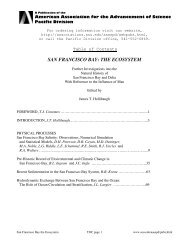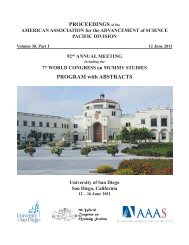Vol 31, Part I - forums.sou.edu ⢠Index page - Southern Oregon ...
Vol 31, Part I - forums.sou.edu ⢠Index page - Southern Oregon ...
Vol 31, Part I - forums.sou.edu ⢠Index page - Southern Oregon ...
You also want an ePaper? Increase the reach of your titles
YUMPU automatically turns print PDFs into web optimized ePapers that Google loves.
ABSTRACTS – Contributed Posters<br />
177 Petrologic and Geochemical Evolution of Lower<br />
Oligocene to Lower Miocene <strong>Vol</strong>canic Rocks of the Western<br />
Cascades <strong>Vol</strong>canic Series, Southwest <strong>Oregon</strong>, JAD A<br />
D’ALLURA (Department of Chemistry, Physics, Materials,<br />
and Engineering, <strong>Southern</strong> <strong>Oregon</strong> University, 1250 Siskiyou<br />
Boulevard, Ashland, OR 97520; rockit@dishmail.net).<br />
Western Cascade volcanism in Southwest <strong>Oregon</strong><br />
exhibits distinct trends from oldest (early Oligocene; ~33Ma)<br />
to youngest (early Miocene; ~23Ma) lavas and related<br />
volcaniclastic rocks. Petrologic and geochemical trends<br />
support complex histories yet are typical of eruptions through<br />
continental crust associated with subduction. Long residence<br />
time within magma chambers is reflected in the abundance<br />
of phenocrysts (normally 20-35%), complex zoning of<br />
minerals, and reaction rims. These features commonly are<br />
coupled with textures indicating periods of rapid growth and<br />
local devolitization during ascent. Assimilation fabrics and<br />
strikingly different generations of plagioclase are evident in<br />
many rocks.<br />
Geochemical relations are consistent with evolving<br />
calc-alkaline trends dominated by fractional crystallization.<br />
Increasing silica and alkali content as well as increasing<br />
Rb, Cs, Ba, Pb and Th and decreasing Ti, Zr, Nb, Ta, Cr,<br />
Ni, and Sc are consistent with maturation of succeeding<br />
magmas. Trends, from tholeiitic to calc-alkaline rocks,<br />
follow decreasingly curved paths on AFM diagrams rather<br />
than the typical straight-line “Cascade” trend suggesting<br />
eruption through thickening and evolving crust. In general,<br />
the geochemistry of clasts in breccias units mirror trends in<br />
the lavas. Older tuffaceous rocks are dacitic while younger<br />
tuffs are rhyolitic showing variable but increasing alkali<br />
content. Atypical variations in trace elements that defy a<br />
simple fractionation model are due to assimilation of crustal<br />
material or complexities within magma chambers. Lower<br />
Miocene rocks contain a higher Mg, Cr, and Ni content<br />
and slightly fewer phenocrysts, suggesting crustal thinning,<br />
opening of conduits caused by faulting, or rapid rise of<br />
magma.<br />
ECOLOGY, ORGANISMAL BIOLOGY,<br />
and ENVIRONMENTAL SCIENCES<br />
178 Characterizing a Local Model System for Studies<br />
of Ecological Stoichiometry of Trophic Interactions,<br />
CAROLYN F WEBER, JEFFREY P HILL, and<br />
AMOEBA (Department of Biological Sciences, Idaho State<br />
University, 921 South 8th Avenue, Stop 8007, Pocatello, ID<br />
83209-8007; webecaro@isu.<strong>edu</strong>).<br />
The elemental stoichiometry of biomass and available<br />
re<strong>sou</strong>rces play an important role in controlling how organisms<br />
interact with each other and their habitats, but the relationship<br />
between these two stoichiometries is poorly understood<br />
in terrestrial ecosystems. A first step in understanding this<br />
100<br />
relationship is studying the physiological homeostasis of<br />
organisms in isolation and in mixed communities across a<br />
range of environmentally relevant re<strong>sou</strong>rce stoichiometries.<br />
Mesocosm studies conducted in a controlled laboratory<br />
setting can potentially provide such insights, but require<br />
well-characterized and small-scale model systems. We<br />
are currently using mesocosms to characterize feedingbehaviors<br />
of organisms associated with soil mosses that<br />
are abundant in local sagebrush steppe. Physical separation<br />
and antibiotic applications have isolated a soil nematode<br />
species, and several bacterial species that can serve as<br />
their food <strong>sou</strong>rce. Based on DNA sequencing of ribosomal<br />
RNA genes, the nematode and bacteria isolated thus far<br />
are most closely related to Panagrolaimus detritophagus<br />
and four undescribed members of the genus Pseudomonas,<br />
respectively. Efforts to obtain axenic cultures from two<br />
species of moss protonema have revealed the presence of<br />
a persistent fungal associate; coarse manipulations of light<br />
and organic carbon availability influenced the balance of<br />
moss-fungus relationships indicating that varied ecological<br />
stoichiometries exert significant control over the type of<br />
interactions (e.g. mutualistic, parasitic) between these two<br />
organisms. Identifying the nutritional requirements and<br />
elemental stoichiometries of individual organisms will<br />
provide the foundation for understanding of how nutrient<br />
availability and trophic flux of key elements contribute to<br />
species composition in local soil moss communities.<br />
179 Defining Microalgae Growth Conditions That<br />
Eliminate Competitive Exclusion and Maximize Lipid<br />
Production for the Purpose of Biofuel Production,<br />
HERBERT A POLLARD IV*, WILLIAM HEWITT*,<br />
and LUKE SUGDEN* (Department of Biology, Boise<br />
State University, 1910 University Drive, Boise, ID 83725;<br />
bioinfo@boisestate.<strong>edu</strong>).<br />
It has been long recognized by population ecologists<br />
that greater species diversity allows for greater biomass<br />
productions. Currently, DOE projections of algal based<br />
biofuels rest on calculation of only single species culture.<br />
Our work investigates the use of mixed species microalgae<br />
cultures to enhance potential for biomass production vs.<br />
single species cultures. We assessed microbial conditions<br />
that permit two microalgae species to grow without<br />
competitive exclusion taking place. Our approach is unique<br />
in that we will use uniculture growth constants on a limiting<br />
growth substrate gradient to determine the concentrations<br />
in which mixed-culture growth can be maintained. Our<br />
work utilizes Monod’s model of growth rate on a single<br />
growth controlling substrate to define the conditions of<br />
mixed culture growth, but also investigate whether the<br />
stage of high lipid production between two microalgae<br />
can be induced at the same range of nitrogen limitation.<br />
If this condition is met, it will allow for the comparison<br />
of net lipid yields of stable mixed cultures vs. single








